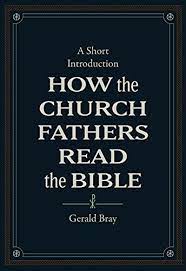Gerald Bray

Reviewed by Josef Muench on 10/10/2022
Gerald Bray, the editor of multiple volumes in the Ancient Christian Commentary Series, is eminently qualified to write an introduction to patristic hermeneutics. Bray’s pedigree aside, Lutheran interest in this book is piqued by his observation that we owe the adjective “patristic” and the designation of early Christian writers as “fathers” to two Lutherans: Johann Franz Buddeus and Johannes Gerhard, respectively (1). But How the Church Fathers Read the Bible isn’t just written for Lutherans. It is intended for anyone who values the Christian past and is dissatisfied with the methods and results of higher criticism.
Introducing a topic as vast as patristic biblical interpretation is no easy task. To assist the reader, Bray includes helpful summaries at the end of every chapter. The concluding chapters, containing several “case studies” and theses on how the church fathers read the Bible, are also helpful. However, given the brevity of this introduction, the interested reader will be disappointed to find neither a bibliography nor suggestions for further reading. Moreover, nearly the first third of the text is consumed with discussions of just who counts as a “father,” language and translation issues, and other topics that are of interest to the scholar but should have been footnoted in an introductory work.
The book’s greatest weakness is that Bray undermines his own chief argument (namely, that modern Christians can recover something of value from patristic exegesis) by taking for granted the interests and assumptions of the almighty “modern reader.” For example, we are told that in the debate over Proverbs 8:22 during the Arian controversy, both parties were mistaken to refer the passage to Christ. “In fact,” Bray writes, “as we now know, the verse is not about the Son at all but about the divine wisdom” (29). Similarly, Bray judges that Augustine was mistaken in his christological reading of the Good Samaritan, Origen was naïve to defend the historicity of Noah’s flood, and Basil of Caesarea was wrong to read the creation account literally. In a revealing paragraph, Bray states that many fathers indulged in a kind of exegesis that “fail[s] to meet the standards of interpretation that we would now expect” (103). Is it really inspiring to read that, despite these great shortcomings, patristic exegesis usually contains a “kernel of truth” worth recovering?
Bray also shows a deep personal distaste for allegory, advancing the contrived distinction between “allegory” and “typology” and lamenting that “even the greatest patristic interpreters” (by which he means the ones most akin to modern exegetical sensibilities) “could not resist finding parallels between the Old and New Testaments . . . whether those parallels made sense or not” (116). What is sorely missing here is a positive account of why such parallels did in fact make sense to the fathers, or why it was unthinkable for Athanasius that “the divine wisdom” might be something other than the eternal Son. There is useful information here for a novice in the field, but more compelling and inspiring introductions are readily available.



